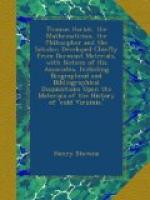The whole question was inquired into. Professor Robertson’s original report was brought out and sent to Dr David Brewster, who printed it in his Edinburgh Philosophical Journal for 1822, volume vi, page 314, in an article on the Hariot papers. In the meanwhile, in 1810, that portion of the Hariot papers that did not go to Oxford was presented to the British Museum by the Earl of Egremont. The division of the papers (on what principle it is difficult to guess) was unquestionably Dr Zach’s. The value is no doubt much depreciated by the separation. Under all these circumstances no one can wonder at the Oxford decision, or that the papers were deemed not worthy of publication. Yet under other circumstances it is almost certain that the two collections when worked together will yield valuable materials for the life of Hariot and the history and progress of English science, discovery, and invention. To Professor S. F. Rigaud is due the credit for the most part of working out the crooked and entangled history of the Zachean fiasco, which has apparently depreciated the real value of these papers. Professor Rigaud’s papers may be seen in the Royal Institution Journal, 1831, volume ii, pages 267-271, in the Proceedings of the Royal Society, iii, 125, and in the Appx to Bradley’s Works. Now to pick up a few dropped stitches. Notices of Hariot by Camden, Aubrey, Hakewill, and others are omitted from press of matter. Gabriel Harvey in 1593, in his’ Pierces Supererogation,’ page 190, exclaims ’ and what profounde Mathematician like Digges, Hariot, or Dee esteemeth not the pregnant Mechanician ?’ MrJ.O.Halliwell’s Collection of Letters referred to on page 174, though falling late under our eye, is most acceptable and thankfully used. Several letters of Sir William Lower are printed from the originals in the British Museum. And so is John Bulkley’s dedication to Hariot of his work on the Quadrature of the Circle, dated Kal. Martii, 1591, the original manuscript of which is in Sion College. There is also an interesting letter from Hariot to the Earl dated Sion June 13, 1619, respecting the doctrine of reflections as communicated to Warner and Hues for the use of the Earl. But the most important letter is the following on page 71 from Sir Thomas Aylesbury, one of Hariot’s executors, to the Earl of Northumberland, respecting some remuneration for the extra services of Warner in assisting him in passing Hariot’s ’ Artis Analyticæ Praxis ’ through the press :
Rt. Ho. May it plese your löp. July 5, 1631.
I presumed heretofore to moue your löp on the behalf of Mr. W. for some consideration to be had of his extraordinary expense in attending the publication of Mr. H. book after the copy was finished. The same humble request I am induced to renew by reson of his present wants occasioned by that attendance.
For his literary labour and paines taken in forming the work and fitting it for




